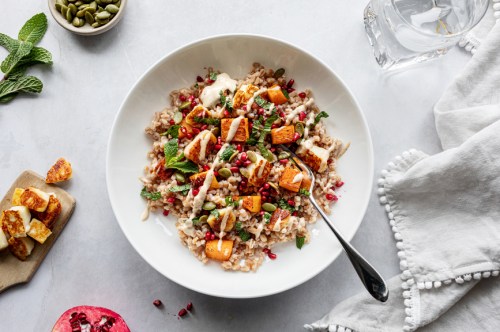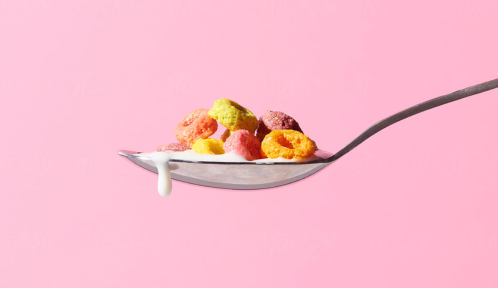Among the many, many delicious plant-based foods we have to choose from, grains are easily among the most versatile and nutrient-rich—and with so many excellent options, who could deny that we could all benefit from noshing on an extra serving (or two… or three) on a daily basis? Grains make meals more flavorful and well-rounded, and they’re loaded with vitamins, minerals, and fiber.
Experts in This Article
National Geographic Fellow and longevity expert Dan Buettner has spent much of his professional career studying the regions of the world that are home to longest-living people, known as the Blue Zones. While each region’s culture, lifestyle routines, and traditions vary greatly, Buettner has distinguished a number of commonalities that he has been able to scientifically link to the residents’ longevity. One of his most significant areas of focus is, of course, the eating habits of those living in the Blue Zones.
It comes as little surprise that the longest-living people of the planet tend to follow a mostly plant-forward meal regime. They consume many high-fiber, protein-packed foods—think plenty of fresh fruits and vegetables, beans, nuts, heart-healthy cooking oils like avocado and olive oil, and (no drumroll needed) whole grains.
It’s easy to see why whole grains are an important part of a longevity-boosting diet. For starters, grains have been shown to effectively fight inflammation as well as provide the body with protection against digestive tract cancers and cardiovascular health risks. Along with beans and starchy tubers, Buetter says that grains make their way into 65 percent of Blue Zone meals.
The most commonly-consumed grains in each of the Blue Zones varies by region (the five, as identified by Buettner, are Nicoya, Costa Rica; Loma Linda, California; Okinawa, Japan; Sardina, Italy; and Ikaria, Greece). “It is important to keep in mind that there is no one ‘healthiest’ grain,” says registered dietitian and longevity expert Erica Mouch, RDN, CD. The best option for everyone, she says, is more whole grains and more variety. (Don’t have to ask us twice.)
Below, find the seven types of Blue Zones grains, or the varieties of grains that the longest-living on the planet eat regularly.
7 Blue Zones grains to consume for longevity-boosting benefits
1. Rice
Several varieties of rice—from white and brown to red or black rice—are staples in all five Blue Zones, but especially Nicoya, Okinawa, and Loma Linda. Brown rice and white rice are essentially the same, but white rice has been processed in a way to remove the outer layers to have a longer shelf life and shorter cooking time. Because white rice no longer has that outer layer, it’s lower in fiber than brown rice, says Mouch. “Brown rice has more B, E, and K vitamins, and twice the fiber, potassium and magnesium as white rice. Brown, red, and black rice have different levels of antioxidants but similar fiber, potassium, and magnesium levels to brown rice,” Mouch adds.
That being said, don’t be so quick to dismiss white rice as “less healthy.” “People will choose brown rice despite it not being their first choice in an effort to be ‘healthy,'” registered dietitian Samina Qureshi, RD, previously told Well+Good. “I see this so often with clients. All food is nourishing and provides our bodies with valuable nutrients that meet our emotional and physical needs. I don’t see brown rice as the healthier option, it just has a different nutritional profile than white rice… Rice is the component on my plate that soaks up all the flavor and brings a dish to life. I love eating white rice with curries, salans, sabzis, stir-frys, chili, kabobs, grilled veggies, and pretty much anything you can think of.” Many residents of the Blue Zones regions would undoubtedly agree.
2. Corn
A daily regimen in Nicoya is making nixtamal corn dough by hand. In this process, corn kernels are soaked in lime, ground into a masa harina corn flour, and baked or fire-roasted into a tortilla. The results are exceedingly delicious. Corn is used in Nicoya for making both savory dishes as well as sweets, like pan de elote, a sweet, custard-y cornbread dessert. Cornbread is also a staple side In Loma Linda.
“Corn is high in lutein and zeaxanthin, two powerful carotenoid antioxidants that support eye health and can help reduce inflammation,” says Mouch. “Corn also contains ten times the amount of vitamin A compared to most other whole grains.”
3. Millet
Millet is a deliciously tender, nutty-tasting whole grain that’s naturally gluten-free. “Millet is a great source of protein, copper, phosphorous, fiber, and antioxidants. It’s also an excellent source of manganese, which supports brain health, bone health, and helps to reduce inflammation,” says Mouch. Like other cereal grains, millet is extremely easy to cook with ands works well in sweet and savory dishes alike. Try it in a fluffy couscous pilaf, breakfast porridge, a grain bowl, or homemade granola.
4. Barley
As grains go, barley has one of the highest fiber counts (along with buckwheat and bulgur). In Sardinia, it’s common to have a slice of pistoccu with meals, which is a delicious barley-based bread. “Barley is a lower glycemic index grain thanks to its rich beta-glucan content, which is an important type of soluble fiber. Beca-glucan consumption has been linked to improved heart health, digestive health, and lowered cholesterol levels,” says Mouch.
5. Oats
Oats have tons of protein, minerals, fiber, and anti-inflammatory benefits that help harmonize your gut microbiome, boost your cardiovascular system, and help you live longer. “Part of oatmeal’s appeal is [also] how many different ways you can make it—and how many other protein-packed ingredients you can add to it,” Keri Gans, MS, RD previously told Well+Good. “It’s basically a healthy vehicle for other healthy foods.”
6. Farro
Farro is a healthy type of wheat that is commonly cooked in dishes Sardinia—think pasta, gnocchi, and bread (swoon). According to Mouch, farro is a rich source of protein and complex carbohydrates, which combined with its higher fiber content, helps support blood sugar control, reduced cholesterol, and digestion. “It actually packs more fiber than brown rice or oatmeal,” she says. “And most of the fiber in farro is insoluble fiber, which helps add bulk to stool and acts as a prebiotic for our gut microbiome to support feeding the ‘good’ bacteria in the gut. This supports overall reduced inflammation and longevity,” says Mouch.
7. Quinoa
Different than the grains from grasses, quinoa is a pseudo-grain (technically, it’s a seed) that comes from a flowering plant, similar to amaranth or buckwheat. It’s also naturally gluten-free. “Quinoa boasts all nine essential amino acids that the body doesn’t make, so it is considered a complete protein,” says Mouch. “This is quite rare for a plant-based food and just adds to the many reasons why quinoa is so good for you.”
Oh hi! You look like someone who loves free workouts, discounts for cutting-edge wellness brands, and exclusive Well+Good content. Sign up for Well+, our online community of wellness insiders, and unlock your rewards instantly.
Sign Up for Our Daily Newsletter
Get all the latest in wellness, trends, food, fitness, beauty, and more delivered right to your inbox.
Got it, you've been added to our email list.










